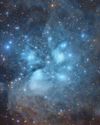
Using a technique called gravitational lensing, the Fast Outgoing Cyclopean Astronomical Lens (FOCAL) will enable us to see deeper into space than ever before. With the ability to view distant objects at huge magnifications, the telescope will be situated between 550 and 1,000 astronomical units (AU) from the Sun, which is the greatest area of magnification possible. Originally devised by SETI astronomer Claudio Maccone in a 1992 paper, FOCAL was formally proposed to the European Space Agency in 2000 and put forward by Maccone at the International Astronautical Congress (IAC) in 2010.
The telescope’s magnification works by distorting space-time, an idea that was published in a 1936 paper by Einstein using his theory of relativity. This was improved upon in 1964 by Sidney Liebes’ mathematical theory of gravitational focusing and then in 1978 by the discovery of twin quasars by astronomer Dennis Walsh.
Esta historia es de la edición Issue 140 de All About Space UK.
Comience su prueba gratuita de Magzter GOLD de 7 días para acceder a miles de historias premium seleccionadas y a más de 9,000 revistas y periódicos.
Ya eres suscriptor ? Conectar
Esta historia es de la edición Issue 140 de All About Space UK.
Comience su prueba gratuita de Magzter GOLD de 7 días para acceder a miles de historias premium seleccionadas y a más de 9,000 revistas y periódicos.
Ya eres suscriptor? Conectar

MYSTERIES OF THE UNI WHERE ARE ALL THE SPIRAL GALAXIES?
There are far fewer spiral galaxies than elliptical ones in the Supergalactic Plane, and scientists are keen to discover why

ZOMBIE STARS
+10 OTHER TERRIFYING SPACE OBJECTS

HOW TO BEAT LIGHT POLLUTION
Thought it was impossible to observe the wonders of the night sky from towns and cities? Think again. Follow our tips and tricks on successfully observing through sky glow

15 STUNNING STAR CLUSTERS
These beautiful stellar groupings are spattered across the cosmos

Eileen Collins "It was a difficult mission...we were the first to see Mir"
Having served as both the first female pilot and first female commander of NASA's Space Shuttle, Collins boosted the involvement of women in space exploration to a whole new level

MARS LEAKS FASTER WHEN IT'S CLOSER TO THE SUN
The Red Planet has lost enough water to space to form a global ocean hundreds of kilometres deep

FUTURE TECH KANKOH-MARU
This ambitious reusable spacecraft will be capable of taking 50 people to and from orbit

THE FINAL FRONTIER
Beyond the reach of the Sun is a fascinating region of the cosmos that were only just beginning to explore

A long-lost moon could explain Mars' weird shape and extreme terrain
A long-lost moon could explain why Mars is so different from the other rocky planets in the Solar System. Today Mars has two tiny moons.

A sprinkling of cosmic dust may have helped kick-start life on Earth
Cosmic dust may have helped kick-start life on Earth. New findings challenge a widely held assumption that this wasn't a plausible explanation.